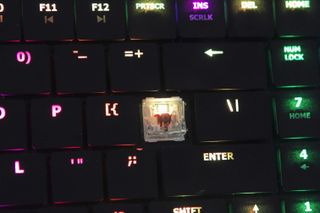The Other Thinnest Mechanical Laptop Keyboard Design

For as jaw-dropping as Adomax’s incredibly thin mechanical keyboard mockups were, we spotted another one in iOne’s Computex booth that was just as thin--actually, probably a little thinner, even. It’s unclear which switches populate this naked keyboard, but we’d be shocked if they were anything but one of Kaihua’s new laptop switches.
iOne, as we’ve mentioned, is a manufacturer, so the devices it shows off are basically reference designs. At first glance, it would seem that this iOne design is the same one we saw in the Adomax booth, but upon closer inspection, you can see the key differences.

Different Switches
First of all, because they have different switches, the iOne mockup is probably thinner. Specifically, it appears to be equipped with the incredibly low-profile 1425 series of Kaihua mechanical switches that use a scissor design. We aren’t certain if the Kaihua switches actually have a lower profile than the Flaretech Prism Slim Edition switches, but we strongly believe that to be the case. Because they were at separate Computex booths (and larceny is outside the bounds of journalism ethics), we couldn’t compare them side-by-side, but we’re all but certain that the iOne design is thinner.
Considering that we estimate the Adomax design at 10mm or less, that’s quite an achievement. You can see how thin this design is compared to a smartphone--we believe it to be just 8-9mm thick.

Laptops And Funky Layouts
The second primary difference is the form factor and layout. As we noted, the Adomax design had a funky layout that seemed to be a cross between a 60% and 75%--almost a true 60% but without ditching the F keys--whereas the iOne design kept the numpad. Even so, the layout is a little odd.
That’s because both of these reference designs are most likely intended for laptops, where space is at a premium and layouts become whatever they need to be. (Awkwardly cram the right arrow key under the edge of the numpad? Sure, why not.)

Clues
Stay on the Cutting Edge
Join the experts who read Tom's Hardware for the inside track on enthusiast PC tech news — and have for over 25 years. We'll send breaking news and in-depth reviews of CPUs, GPUs, AI, maker hardware and more straight to your inbox.
We don’t want to draw too many conclusions from a reference design, but iOne is almost daring us to with the legends on these keycaps. Note, for instance, that the F keys appear to have secondary functions built in. Some are the predictable media controls, but there are five profile buttons and what we assume is a “game mode” toggle. Judging by the special “M” character under the right “Alt” legend, this design hints at being able to program macros onto the keyboard without any software. This design actually does a rather nice job of fitting in as many keys as possible into a compact form factor.
What these legends tell us is that the reference design is aimed at gaming laptops, most likely with an eye towards enthusiast typers who like to create different layouts.
The takeaway here is that there’s more than one reference design for swoonfully thin mechanical laptop keyboards. We’ve already seen a handful of gaming laptops with low-profile mechanical switches on board; assuming consumers dig them, it’s likely only a matter of time before we see them on not just gaming laptops, but higher-end consumer notebooks, as well.
-
jtd871 "Because they were at separate Computex booths (and larceny is outside the bounds of journalism ethics), we couldn’t compare them side-by-side"Reply
If only there existed measurement devices like, oh say, calipers. That way you could take measurements of both separately and compare those measurements later... -
scolaner Reply19823790 said:"Because they were at separate Computex booths (and larceny is outside the bounds of journalism ethics), we couldn’t compare them side-by-side"
If only there existed measurement devices like, oh say, calipers. That way you could take measurements of both separately and compare those measurements later...
If only you'd been there to guide us. -
scolaner Reply19823900 said:Am I right? does that bare switch say "Gateron"?
I can see how you'd think that, but it doesn't say anything at all, I'm afraid. Just the shapes of the switch housing playing tricks on us. ;) (I've blown it up and played with the exposure to have a closer look.)
Most Popular




